Art History
A look to the past guides in the future.
Sixteenth Century
The artists of the island city of Venice combined the lights and colors reflected in surrounding waters with a Renaissance concern for reality. Their style was noted for its brilliant use of color, light, and texture; its swirling, full-bodied figures; and its dreamlike atmosphere.
The first of the great Venetian artists was Giorgione. Although only a few of his pictures still exist, he is regarded as one of the greatest painters in history. His work changed the way people thought about paintings because his paintings weren’t just drawings filled in with color. He put areas of color next to each other without using many lines. When Giorgione died, Titian became the most important Venetian painter. From Giorgione, Titian learned how to use landscape to create moods. Landscapes are works of art that use natural scenery as subject matter. Although he drew and painted every subject you can imagine, Titian was most famous for his skillful portraits of kings, popes, philosophers, and military leaders.
The first of the great Venetian artists was Giorgione. Although only a few of his pictures still exist, he is regarded as one of the greatest painters in history. His work changed the way people thought about paintings because his paintings weren’t just drawings filled in with color. He put areas of color next to each other without using many lines. When Giorgione died, Titian became the most important Venetian painter. From Giorgione, Titian learned how to use landscape to create moods. Landscapes are works of art that use natural scenery as subject matter. Although he drew and painted every subject you can imagine, Titian was most famous for his skillful portraits of kings, popes, philosophers, and military leaders.
Art works
The last great Venetian artist of the sixteenth century was Tintoretto. Tintoretto’s figure drawings used the same full-bodied form and sense of movement in space as those by Michelangelo. In his paintings, Tintoretto emphasized the emotional aspects of a story rather than illustrating it accurately. His highly unique painting style used contrasting light and dark values to suggest a flickering movement. He stretched out the proportions of figures and often showed them making exaggerated, theatrical gestures. The church welcomed this style of dramatic painting because it was experiencing disorder and change. Martin Luther had started the Protestant Reformation in 1517. Many people were leaving the church. Its leaders valued the art of Tintoretto and others because it appealed to the emotions of the people, reminding them that the church was still there to help them find salvation.
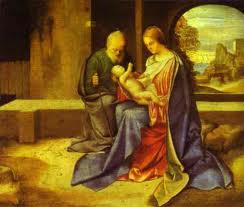 |
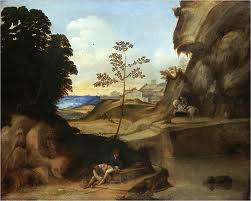 |
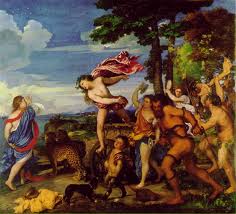 |
| Holy Family Giorgione |
Sunset Landscape Giorgione |
Bacchu & Ariadne Titian |
The last great Venetian artist of the sixteenth century was Tintoretto. Tintoretto’s figure drawings used the same full-bodied form and sense of movement in space as those by Michelangelo. In his paintings, Tintoretto emphasized the emotional aspects of a story rather than illustrating it accurately. His highly unique painting style used contrasting light and dark values to suggest a flickering movement. He stretched out the proportions of figures and often showed them making exaggerated, theatrical gestures. The church welcomed this style of dramatic painting because it was experiencing disorder and change. Martin Luther had started the Protestant Reformation in 1517. Many people were leaving the church. Its leaders valued the art of Tintoretto and others because it appealed to the emotions of the people, reminding them that the church was still there to help them find salvation.
Works of Tintoretto
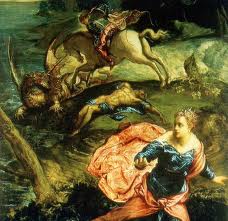 |
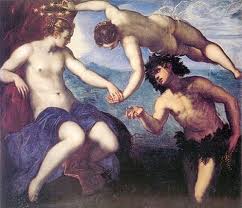 |
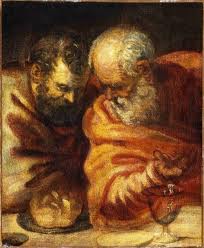 |
| St. George & the Dragon |
Ariadne, Venus & Bacchus |
Two Apostles |
This emotionally charged art later came to be known as Mannerist art. The most striking Mannerist painter lived in Spain. His name was Domenico Theotocopoulos. Since most people had difficulty pronouncing his name, he came to be known simply as The Greek or El Greco. El Greco arrived in Spain from the Greek island of Crete after having spent a number of years in Venice and Rome. El Greco settled in ‘Ibledo, Spain, where he spent the rest of his life. Other Spanish artists were still concerned with representing reality. El Greco, however, was daring enough to express his own inner visions. All of his figures, even in his portraits, were creatures formed by his unique imagination. El Greco’s unfinished painting of St. Jerome illustrates his methods. The figure of the saint was drawn with bold, dark contour lines. The figure was deliberately distorted to suggest the godlike grace of saints. El Greco didn’t intend his St. Jerome to look real; he meant him to look supernatural.
Works of El Greco
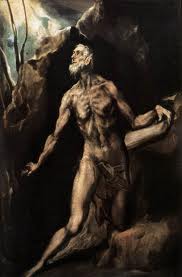 |
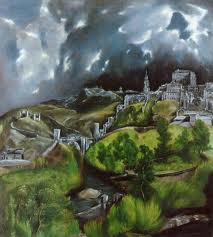 |
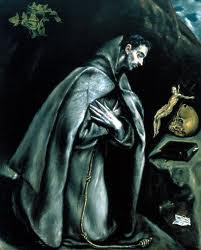 |
| Saint Jerome |
View of Toledo |
Saint Francis |